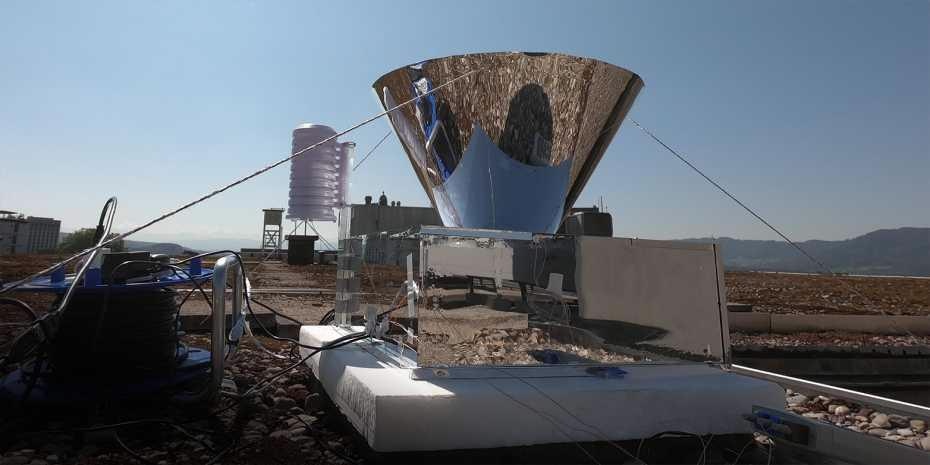Jun 24 2021
A condenser has been developed by scientists at ETH Zurich for countries facing water shortages. This is considered to be the first zero-energy solution for harvesting water from the air across the 24-hour everyday cycle. It works based on a self-cooling surface and a unique radiation shield.
 The pilot condenser atop an ETH Zurich building. Image Credit: ETH Zurich / Iwan Hächler.
The pilot condenser atop an ETH Zurich building. Image Credit: ETH Zurich / Iwan Hächler.
In several regions of the world, freshwater tends to be scarce and has to be acquired at huge expense. Although communities located close to the ocean can desalinate seawater, a huge amount of energy is still needed.
At distances very far from the coast, the only option left is to condense atmospheric humidity via cooling, either using processes that similarly need high energy input or by making use of “passive” technologies that utilize the temperature swing between day and night. Water can be extracted only at night with the help of existing passive technologies like dew-collecting foils.
The reason for this is because the sun heats the foils during the daytime, which makes condensation unviable.
Self-Cooling and Protection from Radiation
For the first time ever, scientists from ETH Zurich have developed a technology that helps them harvest water over 24 hours, both day and night, requiring no energy input, even under the hot sun. The new device includes a specially coated glass pane, which tends to both reflect solar radiation and also radiates away its heat via the atmosphere to outer space.
Therefore, it cools itself down up to 15 °C below the ambient temperature. On the pane’s underside, water vapor from the air gets condensed into water. The process is similar to what is noted on poorly insulated windows during winter.
The glass was coated by the researchers with exclusively designed silver and polymer layers. This unique coating technique enables the pane to discharge infrared radiation at a particular wavelength window to the outer space, without any absorption by the air nor reflection back onto the pane.
One more crucial element of the device is an innovative cone-shaped radiation shield. Heat radiation is mostly deflected from the air, thus safeguarding the pane from incoming solar radiation, while enabling the device to radiate the abovementioned heat outward and thus self-cool, in a completely passive manner.
Close to the Theoretical Optimum
Tests of the new device performed under real-world conditions on the roof of an ETH building in Zurich demonstrated that the new technology can generate at least twice the amount of water per area daily as that of the best existing passive technologies that use foils: the small pilot system with a 10-cm pane diameter offered 4.6 mL of water daily under real-world conditions.
Bigger devices with huge panes would be able to generate more water accordingly. The researchers were able to demonstrate that, under perfect conditions, they could generate up to 0.53 deciliters of water per square meter of pane surface on an hourly basis.
This is close to the theoretical maximum value of 0.6 decilitres per hour, which is physically impossible to exceed.
Iwan Hächler, Doctoral Student, ETH Zurich
Hächler is a doctoral student in Dimos Poulikakos group, who is working as a Professor of Thermodynamics at ETH Zurich.
Generally, other technologies would need the condensed water to be cleaned from a surface, which necessitates energy. In the absence of this step, a considerable portion of the condensed water would adhere to the surface and stay useless while impeding additional condensation.
Scientists from ETH Zurich have made use of an innovative superhydrophobic (extremely water-repellent) coating to the pane’s underside in their water condenser. This makes the condensed water bead up and jump or run off the pane at its own accord.
In contrast to other technologies, ours can really function without any additional energy, which is a key advantage.
Iwan Hächler, Doctoral Student, ETH Zurich
The scientists aimed to design a technology for countries facing water scarcity and, especially, for countries that are emerging and developing. At present, they say that other researchers have the chance to additionally develop this technology or integrate it with other techniques, like water desalination, to boost their yield.
Comparatively, the production of the coated panes is simple, and constructing water condensers bigger than the existing pilot system must be possible. Just like how solar cells contain various modules set up right next to each other, many water condensers could even be placed side by side to make a large-scale system.
Journal Reference:
Haechler, I., et al. (2021) Exploiting radiative cooling for uninterrupted 24-hour water harvesting from the atmosphere. Science Advances. doi.org/10.1126/sciadv.abf3978.